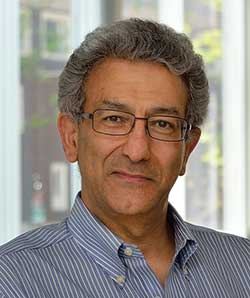Q&A with Nader Engheta in Optics & Photonics News

Stewart Wills of Optics & Photonics News caught up with Nader Engheta at CLEO 2018, the Conference on Lasers and Electro-Optics, being held in San Jose, California this week.
Engheta, the H. Nedwill Ramsey Professor with appointments in the departments of Electrical and Systems Engineering (ESE), Bioengineering (BE), and Materials Science and Engineering, gave a lecture on the nascent field of metaphotonics, in which developments in nanotechnology and materials science are opening the door for structures with unprecedented optical properties.
Early in your plenary talk, you alluded to Richard Feynman’s famous talk in 1959, “There’s Plenty of Room at the Bottom,” in which he envisioned some aspects of modern nanotechnology. You suggested that, similarly, there’s still plenty of room to explore the “extreme” applications of optical metamaterials. Where do you see the biggest potential wins for metaphotonics?
There’s a long list of topics that relate to the “extreme” aspects of metamaterials. To pick just a few: One aspect is to see whether metamaterials can help us informatics — in machine learning, in information processing. Can metamaterials help that? Can they be a programmable platform — can we have FPGA-type light-matter interactions? FPGAs — field-programmable gate arrays — are a very powerful platform in electronics. Can one do that in the form of metamaterials?
Another one goes back to the notion of near-zero-index photonics, which we covered in a feature in OPN two years ago. That, in itself, is another extreme, obviously. And a third example is merging metamaterials with 2-D materials, like graphene. That’s another extreme — can we have one-atom-thick circuits, or one-atom- or few-atoms-thick optical devices? These are some of the extremes that we can pick from the list.
Continue reading at Optics & Photonics News.
